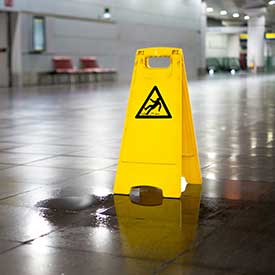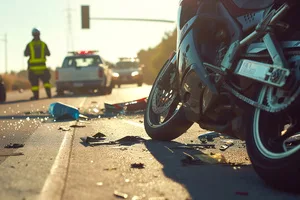- September 25, 2023
- Personal Injury

GET STARTED
Accidents are always unfortunate and can offset your life in unexpected ways. If you were in an accident that you believe to be the fault of another person or entity, it’s understandable to want to hold someone accountable. As bills pile up and those lost days at work start to take a toll, financial compensation can help to ease some of the burden.
But how do you know whether your accident was due to someone else’s negligence? For this, it’s important to understand Texas negligence laws about personal injury, especially the different types of negligence in Texas. Our Texas personal injury lawyer at Crain Brogdon LLP will help you understand how negligence works and whether you have a case.
Call (214) 522-9404 to schedule a case review.
Why Hire the Attorneys at Craig Brogdon, LLP?
At Craig Brogdon, LLP, we are passionate about advocating for our clients and guiding them through the process of their personal injury claims. Our attorneys are experienced in different types of personal injury cases and know what is required to prove negligence.
We have decades of experience fighting for our client’s rights and interests and ensuring they do not get bullied by insurance companies.
We have helped many clients secure a favorable outcome due to our experience and understanding of Texas negligence laws. When you contact our law firm, we will work tirelessly to advocate for your rights while you focus on recovering from your injuries. Our initial consultations are free, so contact us today at (214) 522-9404 to schedule one.
Types of Texas Personal Injury Cases Where Negligence Applies
Sometimes, an accident is just an accident. Slipping on the ice on the sidewalk outside your home or nicking your thumb while cutting vegetables may hurt, but they also aren’t necessarily the fault of another person. However, some accidents are because of another person or entity’s fault.
As a result, Texas negligence laws apply in different types of personal injury cases, including:
- Vehicle collisions caused by drunk or distracted driving or failure to adhere to traffic laws
- Workplace accidents due to a failure to create a safe workplace
- Defective products or other product liability
- Child safety accidents
- Dog bites, etc.
Texas law allows you to file for financial compensation from the at-fault party if your injury results from negligence. However, you must first prove the elements of negligence and understand how Texas negligence laws affect the amount you can receive.
Types of Negligence in Texas
Negligence means failing to act with a level of care that a reasonable person would have exercised under the same circumstances. Generally, two types of negligence apply to personal injury cases in the United States, but Texas only applies one. Below, we have discussed these two negligence types, including the one applicable under Texas law.
Contributory Negligence
Contributory negligence is one of the defenses used by at-fault parties in personal injury cases. When people allege contributory negligence, they say the victim was partly to blame for the accident that hurt them.
Contributory negligence is pretty strict, as it bars the victim from recovering any compensation
Therefore, even if the victim is only 1% at fault, they cannot recover compensation from the at-fault party. The harshness of the contributory negligence law is why many U.S. states do not apply it but choose to use comparative negligence. Texas is one of the states that use a comparative negligence standard.
Comparative Negligence
Texas is a comparative negligence state. According to comparative negligence, each party is responsible for the amount of fault they may have borne in the accident. If you are found to be partly at fault for the accident, the amount of damages you can recover is reduced based on the percentage of fault you bear.
Let’s use a vehicle collision as an example: One driver runs a red light, and another driver, talking on their phone while driving, crashes into them while crossing an intersection. Both drivers bear some fault. The first driver did not adhere to traffic laws, and their dangerous driving made them a risk for traffic. The other driver had the right of way but did not pay enough attention to brake in time to avoid the first car because they were talking on the phone.
In these cases, the court will establish a percentage of fault that each party bears. Based on that percentage, the plaintiff cannot recover certain damages. In a settlement, the insurance company or the defendant’s legal team will try everything possible to blame you. The higher the percentage of fault you bear, the less they have to pay.
There are two types of comparative negligence: pure comparative negligence and modified comparative negligence.
Pure Comparative Negligence
Under pure comparative negligence, you can still recover compensation irrespective of your fault percentage. So, while contributory negligence bars you from getting a settlement if you are 1% at fault, pure comparative negligence allows you to get compensated even if you are 99% liable. Due to the laxity of pure comparative negligence, most states, like Texas, created and adopted the modified comparative negligence.
Modified Comparative Negligence
Under modified comparative negligence, you cannot receive compensation as the victim if your fault exceeds a specified percentage. In some states, the benchmark is 50%, while in others, it is 51%. Under the Texas law, Civil Practice and Remedies Code Chapter 33. Proportionate Responsibility Rem. §33.001, “a claimant may not recover damages if his percentage of responsibility is greater than 50 percent.”
In Texas, you cannot recover compensation if you are 51% or more at fault for the accident. Your fault percentage must be 50% or less to get a settlement from the other party. So, if you are 30% at fault, you can get 70% of the sum awarded as compensation.
The person alleging contributory or comparative negligence has the burden of proving how the victim contributed to the accident and to what extent.
The complexities of proving negligence are why you should always work with a personal injury lawyer. Our lawyers can help you establish your case and get a favorable outcome even when the at-fault party’s insurer or lawyer alleges comparative negligence.
Other Types of Negligence in Texas
Other types of negligence in Texas that apply to personal injury cases are:
- Gross Negligence: It does not deal with fault distribution but deals with the severity of negligent behavior. An example of grossly negligent behavior is driving drunk and on the wrong side of the road while going over the speed limit. If an at-fault party exhibited gross negligence, you can ask the court for punitive damages.
- Vicarious Negligence: It applies to cases where you want to hold a third party responsible for an accident. It is common when you want to sue an entity or organization for the actions of their employees. For example, a truck company that negligently hires a driver with a history of drunk driving is vicariously negligent if the driver causes a collision when intoxicated.
How to Prove Negligence By Texas Law
Proving negligence can get tricky. It’s not as simple as pointing to the defendant’s actions and showing they were negligent. Four elements of negligence must be proven through solid evidence in order to have a valid case for personal injury. These include:
Duty of Care
The first element of negligence is the simplest: There must be proof that the defendant had a duty of care. For instance, drivers should follow traffic laws and be mindful of other drivers. Employers must make their workplace safe and up to code.
Manufacturers must ensure their products are safe and work the way they should. Doctors and caregivers have a duty to those in their care, and pet owners are responsible for ensuring that their pets don’t bite. To do less than the duty of care is a sign of negligence.
Breach of Duty
The next task is to prove a breach of that social contract on the defendant’s part. Did the doctor performing surgery not correctly prep the patient or clean their equipment, leading to an infection? Was the other driver talking on their phone during the accident? These examples constitute a breach of duty.
Causation
It’s one thing to prove that the defendant was talking on the phone while driving. But was that the reason for the car accident, or was the accident caused by your running a red light?
Vehicle accidents, in particular, can be complicated when it comes to negligence. Sometimes, both parties are partly at fault. Fortunately, Texas is a comparative negligence rather than a contributory negligence state, so you can still receive a part of your compensation if you are not more than 50% at fault.
Damages
Finally, you need to be able to prove the damages incurred as a result of the accident. This goes beyond just medical bills and lost wages. How has the accident altered the way that you navigate your life? Damages are split into economic and non-economic damages.
Economic damages include:
- Medical bills
- Disability
- Lost wages
- Funeral expenses in the event of wrongful death.
Pay stubs, bills, and invoices can help to prove economic damages. Non-economic damages may require an evaluation from a mental health professional and some counseling sessions. Non-economic damages include:
- Pain and suffering
- Emotional distress
- Inconvenience
- Loss of society
- Loss of companionship or consortium
- Loss of enjoyment of life.
Accidents can change your life completely, even having long-lasting impacts. It’s crucial to ensure you receive all the financial compensation you deserve.
How Long After an Injury Can You Sue in Texas?
In Texas, you may sue as soon as you are injured — or, more likely, as soon as the medical bills come in for your injury. This is because there is a time limit on how long you can take to file your personal injury lawsuit. So, how long after an injury can you sue in Texas?
By law, the personal injury statute of limitations is two years. The timer starts at the time of the accident or when the injury becomes apparent. For instance, you may not recognize medical malpractice when you wake up. But if you become sick in the following days due to an infection, the day you become aware of the infection is when the two years start.
If you attempt to file a personal injury lawsuit after two years have passed, the most likely scenario is that it will be dismissed out of hand. There are, however, a few exceptions.
One is product liability. In the case of an injury from an unsafe product, you have fifteen years from the date the product was sold to file a lawsuit — or the length of the sale life as stated by the manufacturer, whichever is longer. You have two years from the deceased’s death in a wrongful death case.
Types of Negligence in Texas FAQs
Negligence in personal injury cases is not always easily understood, which leads to questions from victims. Below, we have answered some of the questions frequently asked.
I Was Partially at Fault for My Accident. Can I Still Receive Compensation?
Yes, you can, as Texas is a modified comparative negligence state. You can still recover compensation if your percentage of fault is not more than 50%.
Must I Prove the Four Elements of Negligence to Win My Case?
Yes. All four elements of negligence must be proven to win your claim – proving one or two is not sufficient.
What Happens If I Can’t Establish Negligence? Will I Still Get Compensation?
No. If you cannot prove that the other party involved in the accident that harmed you is negligent, you cannot receive compensation from them.
What Evidence Do I Need to Prove Negligence?
The evidence needed to prove negligence differs based on the type of personal injury case. But in most cases, you’ll need an accident report, medical record, witness statement, and visual images and recording.
Were You Injured Due to Negligence in Texas? Call Crain Brogdon, LLP, Today!
Crain Brogdon, LLP is a nationally recognized, precedent-setting personal injury law firm here to help you get the financial compensation you deserve. We work on a contingency fee basis, so you don’t have to worry about upfront fees. Contact us today at (214) 522-9404 to learn more about how we can help you.

Attorney Quentin Brogdon
Quentin Brogdon has over thirty years of experience and expertise in the field of personal injury trial law. He is board certified in both personal injury trial law and civil trial advocacy. Quentin has received an AV rating from Martindale-Hubbell, the highest possible rating. This rating reflects an attorney’s ethics and abilities according to reviews from fellow attorneys. [ Attorney Bio ]






Recent Comments